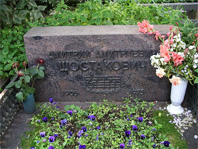The Ninth Symphony is emblematic of the high-wire act required of a Soviet composer under Communist rule. Shostakovich’s transcendent musical gifts won him status as the Soviet Union’s leading composer, a stint as the president of the composers’ union, and international acclaim, despite two periods when he was out of favor with officialdom at home. As a young man, he ardently embraced socialist ideals, but later, after successfully responding to political criticism from the state with his Fifth Symphony, he tried to remain above the political fray. Even when he was out of favor with the Communist regime, he was never dispatched to the gulags. He remained an economically favored hero of the Republic with a country dacha and an active social life with his musical colleagues. In public, he never criticized Stalin or the Soviet government, but in private life he mocked the bureaucracy and its heavy-handed interventions in the creative process. As a result, a sarcastic tone permeates the Ninth Symphony.
Composed near the end of World War II in honor of the military victory in Europe (VE Day—May 8, 1945), Shostakovich adopted a surprisingly transparent neo-classical approach supplemented with a bombastic sneer. Reputedly, he was inspired by playing piano four-hand reductions of Haydn symphonies on a nightly basis with his friend and fellow Soviet composer Dmitri Kabalevsky. Yet Haydn never used low brass and percussion the way Shostakovich does in the Ninth. That enables the Russian to infuse his symphony with a frantic, 20th-century edge that many have interpreted as subversive. Although initially well received, the symphony was banned in his home country in 1948 and not reprieved until 1955.
The Ninth Symphony is divided into five movements. The first, an Allegro in sonata form, is crisp and bouncy, with the upper parts classical. A snare drum adds a brisk military air, and the trombones add some insistent bombast. But even the very neo-classical upper parts, chock full of short, precise notes, are skewed with a scattering of extra beats, giving the rhythm a scrambled, off-balance feel. The Moderato movement opens with a plaintive clarinet solo, later taken up by the flute. It is very Russian sounding. Tension builds as the strings take up a slightly drunken-sounding ascending scale theme. The lonely flute and clarinet return with pizzicato string accompaniment, the theme is passed to the trombone, and the strings let out a descending sigh.
The Presto reprieves the rising and falling scales but against a very different them—evoking a bouncy, balletic tip-toeing with racing clarinet and piccolo. A heroic trumpet solo blasts through. The movement is followed immediately by a Largo, introduced by a melodramatic brass chorale, giving way to a mournful bassoon solo, which some identify as a Jewish theme, perhaps in protest of Stalin’s pogroms. The movement comes to a false cadence, then transitions into the Allegretto, starting with a playful bassoon romp, then building into a triumphal, mad rush to the end.
Notes by Emily S. Plishner
Symphony No. 9 in Eb Major
Op. 70
Composed in 1945
By Dmitri Shostakovich






